» posted on Wednesday, August 7th, 2013 by Linda Lou Burton
Reach For The Stars
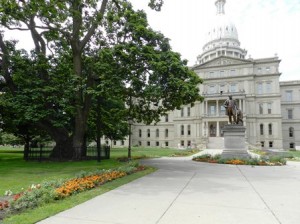 Linda Burton posting from Lansing, Michigan – The catalpa tree was already there when architect Elijah Meyers came to build a capitol. “We figure it’s more than 140 years old,” the groundskeepers told me. Construction on the third Michigan state capitol began in the summer of 1872; the catalpa would have grown as the capitol grew. From the day of the capitol’s dedication on January 1, 1879 until today, when I came for a visit, the catalpa has stood just to the left of the front sidewalk, watching over everything. It is well over a hundred feet tall and 85 feet across
Linda Burton posting from Lansing, Michigan – The catalpa tree was already there when architect Elijah Meyers came to build a capitol. “We figure it’s more than 140 years old,” the groundskeepers told me. Construction on the third Michigan state capitol began in the summer of 1872; the catalpa would have grown as the capitol grew. From the day of the capitol’s dedication on January 1, 1879 until today, when I came for a visit, the catalpa has stood just to the left of the front sidewalk, watching over everything. It is well over a hundred feet tall and 85 feet across 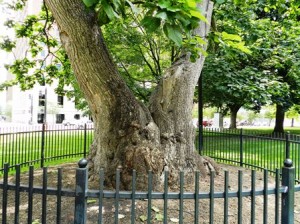 its crown, one of the biggest of its kind in the country. It is fenced for its protection, and steel posts now support two of its extensive limbs; its 20-foot trunk is split, from earliest days, it appears. But it is wearing its age well and each year produces a hearty crop of long thin seed-filled pods, which the groundskeepers collect and give to the Michigan State University arborists for “starting.” Plantings are shared with the community; you might find this catalpa’s babies all over Lansing. “All trees that grow from this tree’s seed split too,” I was
its crown, one of the biggest of its kind in the country. It is fenced for its protection, and steel posts now support two of its extensive limbs; its 20-foot trunk is split, from earliest days, it appears. But it is wearing its age well and each year produces a hearty crop of long thin seed-filled pods, which the groundskeepers collect and give to the Michigan State University arborists for “starting.” Plantings are shared with the community; you might find this catalpa’s babies all over Lansing. “All trees that grow from this tree’s seed split too,” I was  told, as I was handed a seed pod to keep for my own treasure. I tucked it into my backpack and headed on towards the capitol entrance. No steps and no mystery; a clearly marked ground-floor entrance led me directly to the Visitor Information desk, where Matt VanAcker welcomed me and gave me information about the capitol. “A few days ago, there were no desks or chairs in the chambers,” he said. “We are just getting back in order after some major renovation.” I headed for the first floor rotunda, where the tour was already underway, booklet of facts in hand.
told, as I was handed a seed pod to keep for my own treasure. I tucked it into my backpack and headed on towards the capitol entrance. No steps and no mystery; a clearly marked ground-floor entrance led me directly to the Visitor Information desk, where Matt VanAcker welcomed me and gave me information about the capitol. “A few days ago, there were no desks or chairs in the chambers,” he said. “We are just getting back in order after some major renovation.” I headed for the first floor rotunda, where the tour was already underway, booklet of facts in hand.
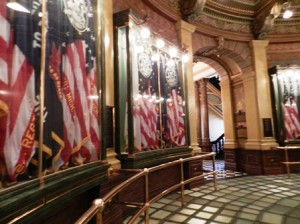 I planned to look up into the dome right away, but the floor caught my attention first. It is glass; in fact there are 976 pieces of glass set in a circular pattern around the 44-foot-diameter rotunda, each about five-eighths of an inch thick. I can’t say I felt the illusion of spinning, but it did feel like floating; and according to my booklet, from the balcony above it would appear that the center of the floor sinks to form a bowl. It was perfectly flat and walkable however; I made a note to look down when I got to the balcony. Over 160 flags encased in glass circled the room; they are replicas of the originals, which are now being preserved in the Michigan Historical Museum and represent the historic battle flags carried by Michigan regiments during the Civil War. One, carried by the First Michigan Sharpshooters, was the first Union flag raised over Petersburg, signaling that the war was almost over. More than 90,000 Michigan volunteers served in the war, which was more than half the military-age males in the state at the time.
I planned to look up into the dome right away, but the floor caught my attention first. It is glass; in fact there are 976 pieces of glass set in a circular pattern around the 44-foot-diameter rotunda, each about five-eighths of an inch thick. I can’t say I felt the illusion of spinning, but it did feel like floating; and according to my booklet, from the balcony above it would appear that the center of the floor sinks to form a bowl. It was perfectly flat and walkable however; I made a note to look down when I got to the balcony. Over 160 flags encased in glass circled the room; they are replicas of the originals, which are now being preserved in the Michigan Historical Museum and represent the historic battle flags carried by Michigan regiments during the Civil War. One, carried by the First Michigan Sharpshooters, was the first Union flag raised over Petersburg, signaling that the war was almost over. More than 90,000 Michigan volunteers served in the war, which was more than half the military-age males in the state at the time.
 I finally walked to the middle of the glass floor and centered my feet securely to look up 160 feet to the top of the inner dome. And I saw stars. Dark blue sky, and golden stars. I’m going to quote from the capitol booklet now, because I can’t think of a better way to describe it: The rotunda was designed with one purpose in mind – to awe and inspire. As you gaze into the starry sky above, you feel that the endless possibilities it represents are just within your grasp. The muses are there, offering their assistance and guidance, while encouraging us to “reach for our stars.”
I finally walked to the middle of the glass floor and centered my feet securely to look up 160 feet to the top of the inner dome. And I saw stars. Dark blue sky, and golden stars. I’m going to quote from the capitol booklet now, because I can’t think of a better way to describe it: The rotunda was designed with one purpose in mind – to awe and inspire. As you gaze into the starry sky above, you feel that the endless possibilities it represents are just within your grasp. The muses are there, offering their assistance and guidance, while encouraging us to “reach for our stars.”
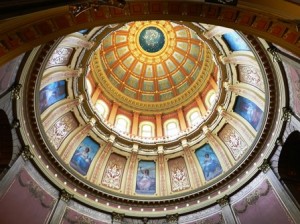 Aweing and inspiring are worthy goals, I say, and I confess to feeling a little of both as I got more and more pictures of the beautiful space. Just below the eye of the dome – the oculus – were eight paintings; according to my booklet they were created by Italian artist Tommaso Juglaris in 1886 while he lived in Boston. He did the work on canvas, which was then glued to the inner dome. The paintings also are intended to inspire; drawn from Greek and Roman mythology, they represent art, agriculture, law, science, justice, industry, commerce, and education. Below the paintings of the muses are elaborately hand-painted designs; I read that the building contains over nine acres of hand-painted surfaces.
Aweing and inspiring are worthy goals, I say, and I confess to feeling a little of both as I got more and more pictures of the beautiful space. Just below the eye of the dome – the oculus – were eight paintings; according to my booklet they were created by Italian artist Tommaso Juglaris in 1886 while he lived in Boston. He did the work on canvas, which was then glued to the inner dome. The paintings also are intended to inspire; drawn from Greek and Roman mythology, they represent art, agriculture, law, science, justice, industry, commerce, and education. Below the paintings of the muses are elaborately hand-painted designs; I read that the building contains over nine acres of hand-painted surfaces.
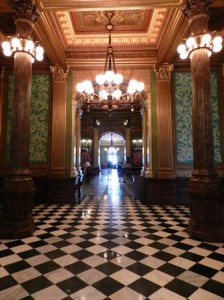 As I began walking the halls, I noticed that a well-coordinated color scheme of satisfying blues, and mauves, carried throughout the building, set off by classic checkerboard black and white tiled floors. The white tiles are an inexpensive marble from Vermont; the black tiles are limestone, also from Vermont; if you look closely you’ll see fossils of marine snails and other marine animals. The family just ahead of me had divided loyalties; the son was looking at the floor, searching for fossils; his sister was looking up at the chandeliers, and sometimes bumping into walls as she walked along, busy with her camera phone. The chandeliers are unique; there are 20 in the building that feature an elk and shield design like that on the Michigan coat of arms. Initially they were gas; now of course they are lit by lightbulbs. The family stopped for a pose by the clock near the elevator. It is a “long drop” clock, and has hung in its present location since 1886, still keeping excellent time. It once functioned as a master clock, driving a number of other clocks throughout the capitol.
As I began walking the halls, I noticed that a well-coordinated color scheme of satisfying blues, and mauves, carried throughout the building, set off by classic checkerboard black and white tiled floors. The white tiles are an inexpensive marble from Vermont; the black tiles are limestone, also from Vermont; if you look closely you’ll see fossils of marine snails and other marine animals. The family just ahead of me had divided loyalties; the son was looking at the floor, searching for fossils; his sister was looking up at the chandeliers, and sometimes bumping into walls as she walked along, busy with her camera phone. The chandeliers are unique; there are 20 in the building that feature an elk and shield design like that on the Michigan coat of arms. Initially they were gas; now of course they are lit by lightbulbs. The family stopped for a pose by the clock near the elevator. It is a “long drop” clock, and has hung in its present location since 1886, still keeping excellent time. It once functioned as a master clock, driving a number of other clocks throughout the capitol.
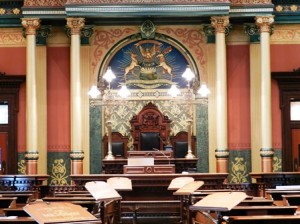 On the second floor the House Chamber was in order and the door was open for a peep inside. Michigan has 110 representatives, so this is the larger chamber. It is a stunning room; the pink-rose mauve color is prominent here; behind the Speaker’s chair is a magnificent version of Michigan’s coat of arms. The elk on the left and the moose on the right flank the American eagle; the Latin words “E pluribus unum” are above. The Latin words below are Michigan’s motto, translated they mean “If you seek a pleasant peninsula, look around you.”
On the second floor the House Chamber was in order and the door was open for a peep inside. Michigan has 110 representatives, so this is the larger chamber. It is a stunning room; the pink-rose mauve color is prominent here; behind the Speaker’s chair is a magnificent version of Michigan’s coat of arms. The elk on the left and the moose on the right flank the American eagle; the Latin words “E pluribus unum” are above. The Latin words below are Michigan’s motto, translated they mean “If you seek a pleasant peninsula, look around you.”
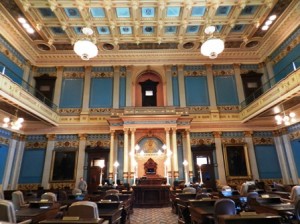 I left the north wing and circled the balcony to the Senate chamber in the south wing; workers here had not quite finished getting things back into place after the new carpet was installed, but that didn’t hinder the view. I think the word “handsome” describes this room, where Michigan’s 38 Senators meet. Here the primary color is blue; hand-painted designs circle the lower portion of the room, and the gallery above; natural light streams in through ruby-and-white etched glass panels in the coffered ceiling; the panels feature the coats of arms of all 50 states . Over the Senate President’s chair is the coat of arms of the United States, a federal eagle in gilded plaster. “Do they vote by roll call?” I asked; “No,” was the answer, as I was directed to look at the panels on either side of the room. The electronic voting boards blend perfectly with the blue color scheme; invisible until turned on during session.
I left the north wing and circled the balcony to the Senate chamber in the south wing; workers here had not quite finished getting things back into place after the new carpet was installed, but that didn’t hinder the view. I think the word “handsome” describes this room, where Michigan’s 38 Senators meet. Here the primary color is blue; hand-painted designs circle the lower portion of the room, and the gallery above; natural light streams in through ruby-and-white etched glass panels in the coffered ceiling; the panels feature the coats of arms of all 50 states . Over the Senate President’s chair is the coat of arms of the United States, a federal eagle in gilded plaster. “Do they vote by roll call?” I asked; “No,” was the answer, as I was directed to look at the panels on either side of the room. The electronic voting boards blend perfectly with the blue color scheme; invisible until turned on during session.
 I caught up with the tour just in time to catch a glimpse of the Governor’s Reception Room; we weren’t allowed to walk in, but we could see the original furnishings; many items were made in 1876 by Feige Brothers Company of Saginaw. Black and white pictures of Michigan governors line the walls, including a picture of Charles Croswell, the first governor to serve in the new capitol, and to use this room. Back out to the central balcony for that promised look down; I agree, it does
I caught up with the tour just in time to catch a glimpse of the Governor’s Reception Room; we weren’t allowed to walk in, but we could see the original furnishings; many items were made in 1876 by Feige Brothers Company of Saginaw. Black and white pictures of Michigan governors line the walls, including a picture of Charles Croswell, the first governor to serve in the new capitol, and to use this room. Back out to the central balcony for that promised look down; I agree, it does 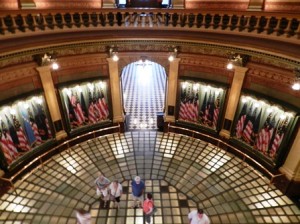 appear as though the middle is sunken (but I assure you it is not).
appear as though the middle is sunken (but I assure you it is not).
I thumbed back through my booklet to make sure I didn’t miss anything; I read more about architect Elijah Myers (1832-1909) and learned this was his first capitol design – he went on to design the Texas and Colorado state capitols and other large government buildings in following years. Myers was chosen from a nationwide search; his design was named “Tuebor,” meaning, “I will defend.” He was given a budget of $1.2 million to work with, so many cost-saving decisions were made throughout construction. No preference was given to Michigan materials; rather, the best materials were selected for the best price. The final cost was $1,427.738.78 and the building contains stone from Ohio, cast iron from Pennsylvania, marble from Vermont, and tin 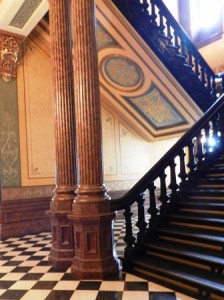 from Wales. Most of the millions of bricks used for walls and ceilings were made in Lansing. Although Myers designed a building with “Victorian elegance,” he came up with ways to provide awe-inspiring beauty at an economical cost, while making it enormously strong and virtually fireproof as well. The marble columns you see throughout the building are not marble at all; the columns are cast iron, painted to look like marble. The capitol’s doors, doorframes, window frames, and wainscoting all appear to be walnut, but almost none of it is. It is inexpensive Michigan pine carefully hand-painted to mimic costly walnut using a technique called “wood graining.” The massive walls, ceilings and floors are solid brick; the distinctive dome is cast iron; all built to last.
from Wales. Most of the millions of bricks used for walls and ceilings were made in Lansing. Although Myers designed a building with “Victorian elegance,” he came up with ways to provide awe-inspiring beauty at an economical cost, while making it enormously strong and virtually fireproof as well. The marble columns you see throughout the building are not marble at all; the columns are cast iron, painted to look like marble. The capitol’s doors, doorframes, window frames, and wainscoting all appear to be walnut, but almost none of it is. It is inexpensive Michigan pine carefully hand-painted to mimic costly walnut using a technique called “wood graining.” The massive walls, ceilings and floors are solid brick; the distinctive dome is cast iron; all built to last.
 I was thinking about the capitol’s star-studded awe-inspiring inner dome as I walked past the catalpa tree again on the way to my car. A simple idea, really, just reach for the stars and keep on growing.
I was thinking about the capitol’s star-studded awe-inspiring inner dome as I walked past the catalpa tree again on the way to my car. A simple idea, really, just reach for the stars and keep on growing.
Michigan State Capitol, 100 N Capitol Avenue, open Monday-Friday, tours available 517-373-2348, http://council.legislature.mi.gov/lcfa/capitol-tours.html
